For more information on vibrations in general, see my previous column article.
⇒ Previous post :. What is Vibratory Finishing? Its features and case studies!
In this column, we will focus on vibration finishing on stainless steel.
I would like to introduce the details based on the merits and demerits of vibratory finishing on stainless steel and frequently asked questions from customers.
I would like to introduce the details based on the advantages and disadvantages of stainless steel vibration and frequently asked questions from customers.
contents
- 1 Advantages and disadvantages of stainless steel vibration finish
- 2 Frequently asked questions from customers
- 2.1 (1) Stainless steel grades that can be manufactured
- 2.2 (2) Is it possible to finish stainless steel with a rough surface, such as hot-rolled steel No.1 and HOT-type steel?
- 2.3 (3) Is it possible to finish shaped objects or laser cut shapes?
- 2.4 (4) Support for customization
- 2.5 (5) How do you finish small items and correct welding?
- 3 Finally.
Advantages and disadvantages of stainless steel vibration finish
Advantages
The advantage of a vibration finish on stainless steel is that it reflects less light and gives a calm and elegant impression.
Also, although it is said that scratches are generally less noticeable, the stainless steel vibration finish sold in general has a shallow polish, and scratches are as likely to occur as with the stainless steel hairline finish. However, the stainless steel vibrations sold for general use have a shallow polish and are prone to scratches as well as stainless steel hairline finish. If you choose a product with scratch resistance, please let us know in advance so that we can recommend a suitable product for you.
In terms of processing, this product is easy to use and easy to correct by welding.
Demerits
The disadvantage is that it is easy to get hand stains.
This is a very important factor. If you are going to use it in an area that is frequently touched by hands, we have a lineup of products with vibration finishes on stainless steel that are relatively resistant to hand stains.
In addition, we have recently seen a large number of cases of hand stain prevention before handover to the owner.
In some cases, this becomes an immediate problem because the owner touches the product and the same hand stains appear.
In this case, we recommend Macoat_GC, a fingerprint resistant coating material.
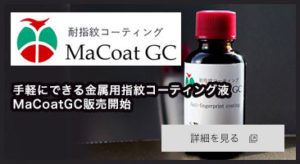 ⇒ Sales of “MaCoat GC,” a fingerprint-resistant coating solution
⇒ Sales of “MaCoat GC,” a fingerprint-resistant coating solution
This is a handrail with a vibration finish to stainless steel that is often used.
This requires both fingerprint and scratch resistant properties and design.

⇒ Related Articles :.【Stainless steel round pipe (for handrail)】_shines with waves
We will provide you with suggestions on how to care for it.
Frequently asked questions from customers
(1) Stainless steel grades that can be manufactured
We are often asked about the materials that can be used to finish stainless steel vibration finish.
Stainless steel, titanium, aluminum, copper, brass, and other materials used in everyday life can be used.
Let’s focus on stainless steel.
The base grade of stainless steel for general-purpose stainless steel vibration finish is basically SUS304.
Depending on the combination of gloss and surface quality, customers may choose to use SUS304 No.2B or SUS304BA.
Looking at the current order situation, the number of orders for SUS304BA base metal has been decreasing recently.
Stainless steel vibration finishes are used for elevator doors, fittings, store fixtures, and kitchens.
There is a key point here: if the welded structure needs to be modified, partial repair or modification of the welded area is required if there is a possibility of on-site repair.
In order to match the color, tone, and luster of the normal stainless steel vibration surface, stainless steel vibration finishes that have undergone a polishing process called “base polishing” are suitable.
For products that are simply bent, stainless steel vibration finish from SUS304 NO.2B base material is used.
Now, SUS304 NO.2B is a general-purpose stainless steel. There is a risk of first rusting in salt-damaged areas (near the sea), places with heavy NOx SOx, yellow sand, PM2.5, and places with good acid rain.
Therefore, high corrosion resistant stainless steels such as SUS316, SUS445, NSSC220M, NSSC2351, etc. are used as stainless steel grades in these areas these days.
⇒ For more information about stainless steel grades, please see nipponn steel HP HPへ
In other words, stainless steel vibration finish can be finished on almost any stainless steel grade.
(2) Is it possible to finish stainless steel with a rough surface, such as hot-rolled steel No.1 and HOT-type steel?
We often hear about this too.
As it turns out, it is possible to finish stainless steel vibration finish even if the surface condition of the hot material is uneven.
The surface of the hot material is smoothed by grinding (a non-cutting design finishing process) to form the base material. By doing so, a beautiful stainless steel vibratory finish can be applied.
In addition to plate shapes, stainless steel vibration finish can also be applied to long shapes (up to 8 meters) such as steel shapes, round pipes, square pipes, and flat bars.
Because of the difficulty of transportation, almost up to 6m is the general-purpose product.
 Products ⇒.Stainless Steel Vibration finish Square Pipe
Products ⇒.Stainless Steel Vibration finish Square Pipe
(3) Is it possible to finish shaped objects or laser cut shapes?
We get this question a lot.
It is possible to finish laser cut stainless steel into cold-rolled or hot-rolled materials.
However, in the case of hot-rolled material, grinding marks may appear due to the grinding and polishing process described above.
It is necessary to discuss the design of the product before manufacturing.
(*Whether to use vertical or horizontal lines…)
Next is the case of three-dimensional shapes, which requires a longer meeting.
If there are a lot of welded parts or complicated bent shapes, there are several patterns to be finished.
<Substitutional patterns>
(1) Stainless steel vibration finish plate shape polishing process ⇒ Shape forming, welding process ⇒ Modified vibration polishing
(2) Pre-polishing process ⇒ Shaping, welding process ⇒ All modified polishing process ⇒ Finish vibration finish
This is approximately how the process works.
This process is the same for bead blast finish.
It is necessary to decide the processing method based on the final product to be finished.
This is a complex case.
This kind of complex case often occurs in high-end applications such as doors, kitchens, store fixtures, and signs.
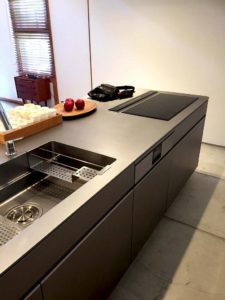
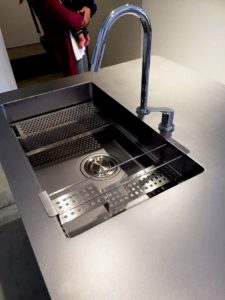
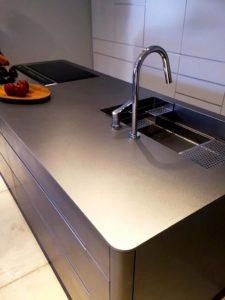
In any case, if there is a proper discussion, a beautiful stainless steel vibration finish product can be completed even for shaped objects.
(4) Support for customization
There are several design variations in the basic pattern.
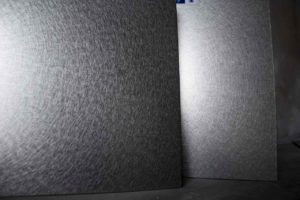 Left: MAKO-59A Right: MAKO-18A
Left: MAKO-59A Right: MAKO-18A
It is possible to customize the size of the object or symbolic case.
It is possible to customize the eccentricity speed, speed, and pressure.
However, if the customization is not done within the scope of processing correction, it may not be possible to fix the problem after processing, even if the shape of the plate is good.
(5) How do you finish small items and correct welding?
We, a design metal manufacturer, use our own facilities to manufacture stainless steel
vibration finish products.
The equipment is huge and extensive, so it is not generally available for use.
Therefore, we generally use a double-action sander to vibration finish stainless steel.
It’s a little bit of know-how, but if you adjust the air pressure, match the rotation speed with the one to be corrected in advance at a similar position, and match the type of paper or non-woven cloth to be polished with a similar one in advance, you can beautifully vibration finish stainless steel without fail.
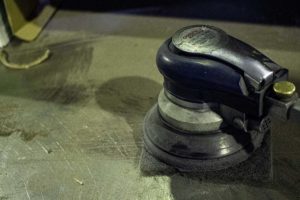
Finally.
Stainless steel vibration finishes are used in familiar places such as doorknobs, handles, automatic doors, and doors that are touched by human hands.
With a little ingenuity, they can be used for a long time and become a product that people will never get tired of.
We would be happy to consult with you before manufacturing.
